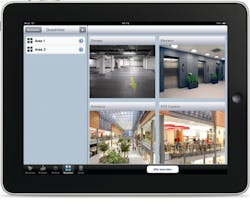Philippsburg, Juli 2012: Just in time for summer, the next version of the SeeTec software is already in the offing: The new release 5.4.3 supports not only about another 200 camera models from many manufacturers, but also simplifies the handling of alarms and ensures an even more efficient management of stored image data. In addition, there are optimizations for extremely large and rather small output media: for large screen displays and the iPad.
To the number of See Tec-Wizards, which make an easy configuration of the system possible step by step, the SeeTec Alarm-Wizard has been added, so that configura-tion of new alarm scenarios has been eased up even more. Fundamental changes have also taken place concerning the management of stored image data. Thus, due to the so called “Data Aging”, the number of images stored per second can be further reduced after a certain period of time in order to increase the memory requirements for older records. Especially in systems with high memory requirements (many cam-eras, long recording time, high frame rates), the Data Aging allows an even more effi-cient storage management.
Also on the client side, the system resources of modern multi-core systems can be used better with the help of the new SeeTec version. In addition to the known 32-bit client, there is now a 64-bit variant available that can address a distinctly larger vol-ume of the system memory. In addition to this, the layer editor introduced in 5.4.2 could also be further improved: You can now create and edit views with up to 64 im-age tiles. These changes are particularly relevant for large-screen systems, which are often used in security control rooms; here, often a large number of cameras has to be displayed live simultaneously. But even for small output media, the new SeeTec ver-sion can come up with innovations: For the SeeTec Mobile Client for iPad, a multi-view has been developed, with which up to four cameras can be displayed simultane-ously.
Also on the hardware-side, the new SeeTec version provides some alterations: Thus, for the first time, there is a generic ONIVF driver available, which enables the integration of ONVIF compatible camera models. Supported are (depending on the range of functions of the camera) streaming via RTSP (MJPEG, MPEG4, H.264), Dual Streaming, PTZ control and digital outputs. Ulrich Heißler, product manager and therefore responsible for the integration of new camera models into SeeTec, comments: “While the range of functions of the first ONVIF compatible cameras was usually very limited via the generic interface, a high number of camera models now reliably provides common basic functions. It is important for SeeTec not only to signalize compatibility due to the ONVIF driver, but also to make a truly practicable tool available to our customers.”
What is remarkable about the new SeeTec version, is the number of newly added camera models: In 5.4.3 over 200 new products were integrated, further new manufacturers were added (IDS, LG, LTV, UTC/TruVision, for example). Moreover, SeeTec now supports in both live and archive mode the dewarping of images taken with 360°-lenses by ImmerVision.
Latest in Video Surveillance






